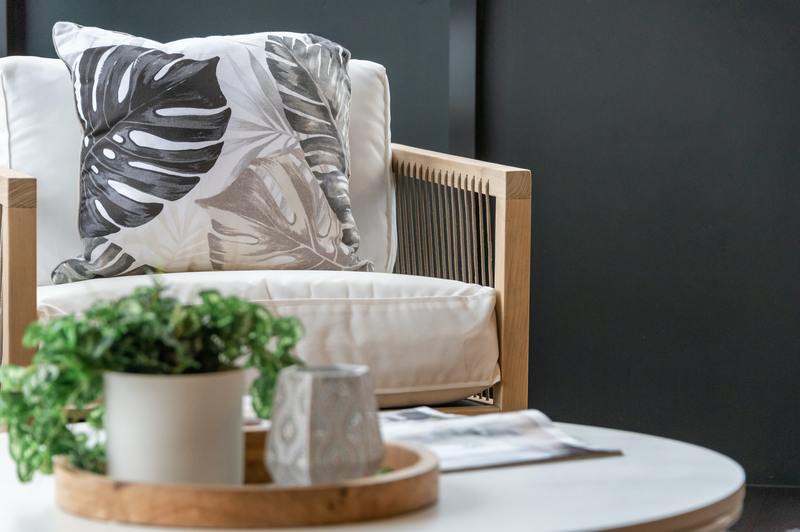The ideal way on how to prevent mildew on outdoor cushions is to protect them from water damage. But before that, read about what leads to mildew growth in the first place.

Mildew And Outdoor Cushions
Mildew spores are everywhere because they are airborne. This means that almost all household surfaces are vulnerable to mildew growth.
However, mildew does not just grow out of the blue. It needs four conditions before settling on a surface.
First, it needs a food source. Dirt, dust, and other organic materials can be food sources for mildew.
Second, it needs air. Mildew and mold cannot exist in tightly-sealed spaces because of the lack of air.
Although, you cannot seal your house entirely as you need air to breathe. This makes it easy for mildew to grow in your household.
Third, mildew needs a specific temperature to grow. It cannot exist in places where the temperature is too hot or too cold.
Most households have a standard temperature because it’s necessary for us too. Hence, this condition is not hard to cross off the list, too.
Lastly, mildew needs moisture to grow. This is why mildew and mold are often water-damaged products in the household.
Water damage is a serious issue because it leads to mildew and mold growth and because it can weaken your home. Hence, the best way to prevent mildew growth on any part of your home is to protect it from water damage.
Outdoor cushions can still be vulnerable to mildew growth. When it rains, they can get wet and house mildew.
Mildew only takes a maximum of two days to grow on wet fabric. If you leave them for weeks, it may get to the point that even vinegar cannot remove the mildew growth.
Signs Of Mildew Growth
One of the most obvious signs of mildew growth on your outdoor cushion is the fabric’s white powdery or downy texture. Mildew’s texture can either be powdery or downy.
On the other hand, mold has a fuzzy or slimy texture. One way of differentiating mold from mildew is by its surface.
If you want an answer to “what does powdery mildew look like” click the linked article. It will help guide you in differentiating between the different types of mildew.
However, we do not advise you to touch mildew or mold. Coming in contact with either fungus would likely result in skin allergies.
Another sign of mildew growth is the smell. It may be more challenging to notice the scent since it’s outdoors.
Also, we do not recommend you sniff the outdoor cushions because the mildew spores may give you respiratory issues. If you ever need to check your cushions for mildew, be sure to wear gloves and a mask to avoid direct contact.
Can You Remove Mildew On Outdoor Cushions?
Yes, of course. Most mildew contaminations aren’t severe, so household items can remedy them.
If you do not want to use vinegar or baking soda items, check this article on where to buy CLR mold and mildew remover. CLR mold and mildew remover are very effective for these kinds of issues.
However, if you’re okay with household items, you have a wide variety of choices to choose from. You can use vinegar as it kills and prevents future mildew growth.
The downside of using vinegar is the smell. So, another option is using baking soda.
You can make it into a baking soda paste or spray. Baking soda also removes the musty odor from the outdoor cushions, so it’s an added advantage.
Lastly, you can use tea tree oil. It has been proven to have antibacterial as well as antifungal properties, making it an excellent choice against mildew contamination.
Ways To Prevent Mildew Growth On Outdoor Cushions
Knowing how to remove mildew from your belongings is not enough; you should also make necessary adjustments to prevent future growth.
1. Spray waterproofing products
Since water damage leads to mildew growth, you can prevent contamination by waterproofing your cushion. Before spraying a waterproofing product, do a spot test if the fabric is compatible with the brand.
If it’s compatible, spray two coats of the product. Ensure that you do not saturate your cushion, as this may still count as water damage.
2. Maintenance
Do routine checks on your cushions for mildew by flipping them occasionally. Also, regularly clean your cushions either with a brush or a vacuum.
If your cushion’s fabric ends up getting soiled, clean it up immediately. Food debris plus moisture would naturally lead to mildew growth, so it’s best to prevent that from happening.
When washing the cushion with a hint of mildew, mix a teaspoon of dishwashing soap and borax into a quart of warm water. Do a spot test on your outdoor cushions first to check for discoloration.
If it’s okay, proceed with cleaning off the mildew from the cushion’s fabric. Repeat these steps if you deem them necessary.
Conclusion
The most important tip on how to prevent mildew on outdoor cushions is ensuring that the cushions are kept clean. Keeping them clean involves being dirt- and moisture-free.
